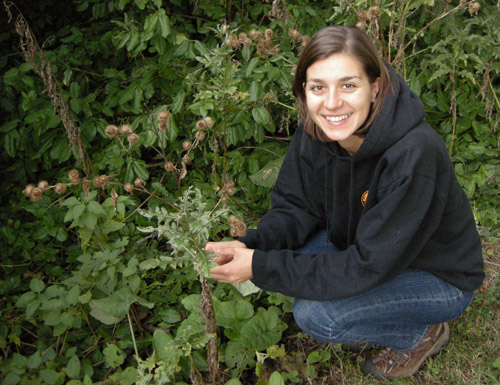
Take a walk in the woods and you’ll find yourself surrounded by many different types of plants. Within a small area you’ll often find several flowering plants, some ferns, a couple of different kinds of grasses, bushes, trees and more.
The diversity of plant life in the forest is something we take for granted, but PhD student Marina Neytcheva says that community ecologists have been trying to make sense of this diversity for a long time. Moreover, this quest for understanding is particularly pressing because current changes to the environment and habitats may lead to the loss of plant species in years to come.
Right now, Neytcheva has more questions than answers, but as one of two University of Guelph winners of a 2011 Vanier Canada Graduate Scholarship, she hopes her research will provide some answers to help us better understand what needs to be done to protect our remaining forests.
In the past, she has studied species coexistence in plant communities. “Ecological theory on competition suggests that we shouldn’t see as many different species co-occurring in a community as we do,” she explains. “If two species are both competing for the same limiting resource — for example, nitrogen —theory predicts that only one should prevail by getting more of the nitrogen, and that eventually the other will be excluded, or driven to local extinction.” Since all plant species have the same basic needs for resources (light, carbon dioxide, water and soil nutrients), based on competition theory, we should see only a few species — the best competitors. In reality, though, plant communities tend to be very diverse.
Neytcheva says some possible explanations for this have been put forward. One, referred to as neutral theory, is that species are more or less equal in terms of their abilities to obtain the needed resources, so there is no real “winner,” and species coexist without difficulty. Another explanation, which falls under the auspices of niche theory, is that while one species may be better in terms of acquiring one resource, another could be better in acquiring another, so both can co-exist by avoiding direct competition for the same resources.
Her research for her master’s thesis, completed at St. Mary’s University in Halifax, sought to explore the relative importance of niche and neutral theory by conducting a study in a deciduous forest understory community in Cape Breton Highlands National Park. The understory of a forest consists of low-lying vegetation on the forest floor and can include both herbaceous plants and woody seedlings and saplings. “I found that competition, as a structuring mechanism, did not seem to be as important as generally thought, at least in this particular community. Other factors, such as herbivory (plants being eaten by animals) and positive interactions between species may be more important than expected.”
Neytcheva has now come to the University of Guelph to work with her co-advisors, Prof. Andrew MacDougall and Prof. Karl Cottenie, on questions related to understory species persistence in deciduous forest fragments in southwestern Ontario.
“Prior to European settlement, more or less continuous forest covered southwestern Ontario,” Neytcheva explains, “but much of the forest has been cleared for agriculture and urban development, so only disjunct forest fragments — isolated patches — remain today. Some are in provincial parks, some on private property, and some have been bought by the Nature Conservancy of Canada.”
Neytcheva’s PhD research will focus on the effects of forest fragmentation on the long-term persistence of species, among other things. “Will the plant species we see in the forests today still be there in 100 years?” she asks. “We don’t really know. Many plants are long-lived, so the effects of habitat loss and environmental change might not become obvious for decades, but it is important to know if any or all forest understory species are on their way to extinction, or if their populations are stable and self-sustaining. We can’t wait 100 years to find out, because at that point it may be too late to take steps to prevent plant population collapses.”
Part of her research includes gathering historical data about forest fragments so she can identify any changes from the past. “I’ll also be gathering data over three or four years that we can use to further test ecological theories in an attempt to understand how natural communities really work,” she says.
Receiving the Vanier scholarship means her time is freed up to focus on her research, without needing to take on part-time work. “I am passionate about ecology and its implications for conservation,” she says. “How do we best preserve our forests and nature for future generations? I wonder, at times, if we have already altered natural communities beyond a state of repair. Establishing and maintaining protected areas may not be solely sufficient to ensure species persistence, but I hope my research will give us some answers about what else can be done.”